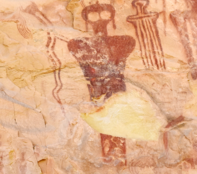BACK ROADS UTAH
Photographically Preserving Utah's Treasures Before Time Takes Them From Us
SEGO CANYON ROCK ART AND THE GHOST TOWN OF SEGO
Sego Canyon contains rock art from three different Native American Cultures. The earliest art, Barrier Style is estimated to be up to 5,000 years old.
The Fremont Style Panel is very well preserved, showing large human figures, mountain sheep and geometric designs. Most of the figures are similar to those found in Nine Mile Canyon. The exception is the scientific graph style petroglyph that is either a sort of measurement of something or perhaps an indicator of distance to ??. The human figure to the left and bottom of the graph appears to be a body wrapped for burial, mummy style. The pictographs and petroglyphs are very well preserved. The panel also includes a hunter pursuing a mountain goat with bow and arrow.
The Ute Historic Panel is the most recent, dating back to after AD 1,450, after the Spanish had brought horses to the Americas. It also depicts a battle that may have taken place between the Utes and the Spaniards. There are obvious red slashes on the horse and what looks like a red spear entering the back of the horse which upon closer examination looks like a human body painted red. There is also a hunt of what may be buffalo taking place on horseback.
Barrier Style Panels: These two panels of pictographs include life size human shapes that lack arms or legs and have insect-like eyes and skull size heads. The large panel is on the west side of the canyon close to the petroglyphs. If you look very closely at the petroglyphs, there are very faded and old barrier style pictrographs above the petroglyphs. These pictographs are estimated to be up to 5,000 years old. There is a great similarity of these pictorgraphs to the panes found in Horseshoe Canyon.
It is a violation of Federal Law and human behavior to deface or harm archaeological artifacts.
Note the area where a portion of the sandstone is missing from the panel. The one on the left has two square boxes drawn into it. This took place in 2020. Photo on right was taken in May 2020. The defaced panel at left was taken on July 10, 2020.
This Fremont Style Panel was created between 1,100 and 1,350 AD and is very similar to the triangular depiction of human figures found in Nine Mile Canyon. The image on the right appears to represent a male and the figure on the right a female. This assumption is based on the depictions in the genital area of the figures. The scientific-like graph is unique and is something I have not seen at other sites, visited or studied in my research. There is a hunt of mountain goats taking place at the top right. There appears to be a mummy at the bottom left of the graph.
This Ute Historic Panel is across the creek that once flowed to the west of the other panels at the mouth of Sego Canyon and was created after 1,450 AD. This panel is of interest because it depicts at least three different shields and what appears to be warriors at the back of a horse that seems wounded and appears to have a red (dead) human figure atop it. This panel is the only panel I have viewed that depicts actual warriors engaged in what may be a battle, but it also shows Ute's of Spaniards on horseback hunting what appears to be a buffalo. The ghost town of Sego is 3 miles further to the north of the rock art panels and a 4-wheel drive vehicle is recommended but not necessary unless there is concern of a storm.
SEGO GHOST TOWN
Segp Ghost Town history began with the discovery of high-grade coal by a rancher, Harry Ballard, in the early 1890's. He began operating in 1911 and sold the mine to a group of Salt Lake City investors. The new owners built a store, a boarding house and other buildings. Trouble started almost immediately when the water supply for Sego dried up. Some of the miners were not paid for a long duration of time but received company script which allowed them to purchase food and necessities for their families. In 1933, the miners became members of the United Mineworkers Union. On November 1, 1947, the mine was close the the property sold at auction.
Most the stone and concrete walls of the Company offices, and boarding house still stand but the roofs and wooden floors have given way to time. The large wooden structure which may have served as the company store has completely collapsed but the wood remains in a large pile across the canyon road. Remnants of a number of the miner cabins built into the west hillside of the canyon wall remain. for exploration. Beware of rattle snakes and enjoy the huge multi-color lizards.
The Boot Hill Cemetery remains in place at the entrance into the portion of the canyon that leads to the ghost town of Sego.
Along with graves from the period, there are a several recent graves, one with a date of death in the 21st Century.

© 2018 - 2021 Raymond Cannefax - All photos are Copyright protected and may not be reproduced without written authorization.
Double click here to add text.






